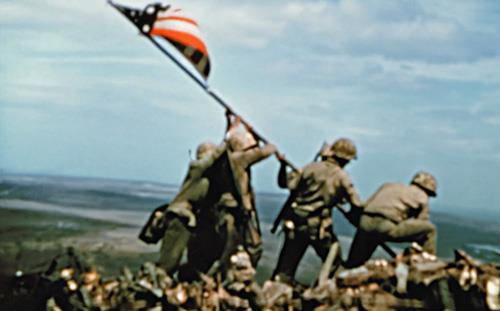
Amid the focus on the 75th anniversary of the Hiroshima bombing, a new documentary pivots slightly to recount the Pacific war that set the stage for that stark moment.
Apocalypse '45 is one of those new-breed productions that will run for two weeks in theaters then pop up on television over Labor Day weekend on the Discovery Channel family.
A "theatrical release" these days, of course, is problematic, but several dozen theaters around the country will be showing it. In other words, it's really a TV production that's getting select preview exposure.
In any case, the appeal of Apocalypse '45 lies mainly in its extensive use of film footage shot in the Pacific from 1941 to 1945. Much of it is in color and originally intended for inclusion in a World War II film being produced by director John Ford.
Apocalypse '45, accordingly, has been called a lost John Ford movie, which turns out to be a bit of an exaggeration.
The footage is fascinating, but often fragmentary – a few seconds of soldiers before an island invasion, grainy shots of combat airplanes being shot down, photos of explosions aboard ships.
Most bracing are the shots of the dead, sprawled on battlefields. It's impossible to do honest war photography without these shots, which makes it no less wrenching to see them.
Several film sequences will draw nods of recognition, including the chaos in Pearl Harbor when the Japanese attacked on Dec. 7, 1941, and triggered the Pacific war. We also see video taken when U.S. Marines raised the American flag on Iwo Jima, an image that became the most iconic of the war.
Apocalypse '45 has little narration, just explanatory messages or geographic identifiers on the screen. But not having a narrator doesn't mean it doesn't have voices. We hear running recollections from some two dozen World War II veterans, now in their 90s or older and, literally, the last men standing.
Their testimony is often riveting, as they recall how the war looked day-to-day from inside, on the ground or in the ships.
Their recollections take us from Pearl Harbor through the island-hopping campaign by which the Americans, at grievous cost, slowly reclaimed the ocean and tightened a noose around the island of Japan.
In virtually every segment, Apocalypse '45 stresses the expectation that surrounding Japan and finally forcing it to surrender were two separate missions, the latter far more difficult than the former.
Because the Japanese had vowed to fight to the death, it was projected by the U.S. military that an invasion of the Japanese homeland could cost up to a million American lives.
Evidence for this projection included the fact that extensive bombing of Tokyo had already caused an estimated 100,000 civilian deaths and had made no apparent dent in the Japanese resolve.
The documentary takes viewers to Okinawa and Iwo Jima, recounting the hill-by-hill combat that left tens of thousands of Marines and a multiple of Japanese soldiers dead.
Apocalypse '45, directed by Erik Nelson, does not come right out and say that this level of resistance made the use of the atomic bombs on Hiroshima and Nagasaki essential.
It provides all the arguments to leave that impression, however, suggesting there was merit to the argument that dropping the nuclear weapons saved more lives than it cost.
That said, some of the veterans here question the morality of dropping those bombs, and the documentary also includes the dissenting note from General Curtis LeMay, who had sharply escalated the conventional bombing campaign, but feared that using atomic weapons opened the door "for every other country" to do the same.
What's indisputable in Apocalypse '45 is the sheer brutality and human cost of war. However justified the cause, there's no suggestion here of glory – just gratefulness that sheer luck enabled you to survive while the soldier next to you did not.
The film and the narration from the veterans make Apocalypse '45 a valuable history lesson. Its broader message was articulated almost a century earlier by General William Tecumseh Sherman, who said, simply, that war is hell.